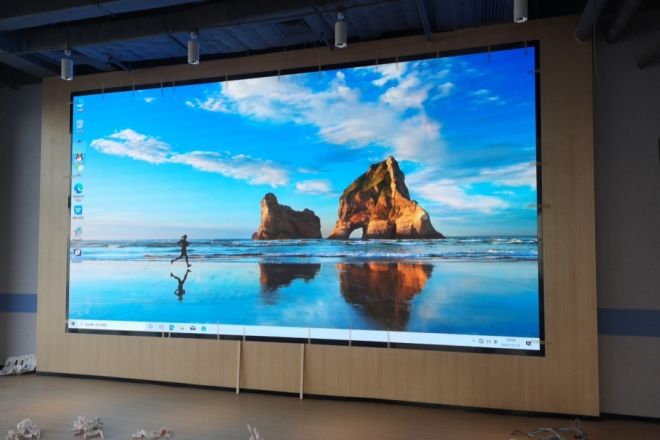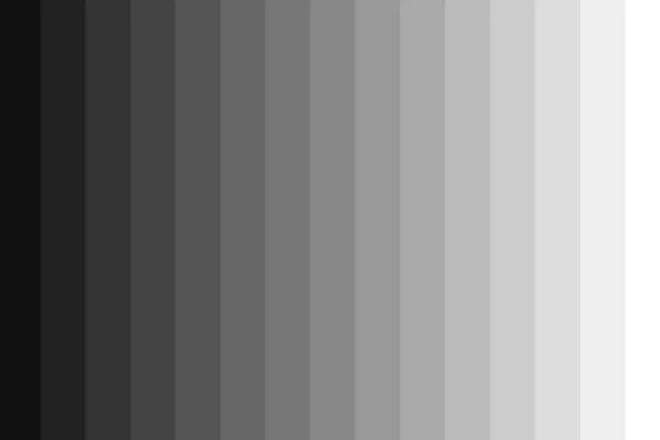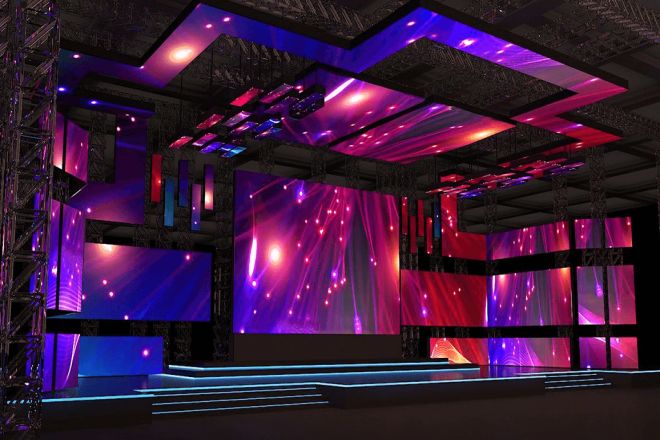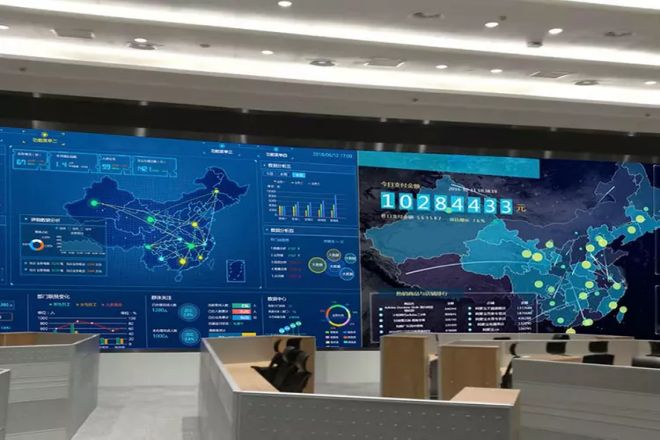Introduction

In today’s rapid development of digitalization and informatization, LED display screens are widely used in various fields with their unique advantages. Whether it is a busy street, a lively shopping mall, an elegant theater, or a quiet museum, we can see LED display screens.
However, with the continuous advancement of display technology, people have higher and higher requirements for the display effect of LED display screens, among which the performance of dark color is particularly critical. Dark color not only affects the overall visual experience of LED display screens but is also an important factor in improving picture quality and enhancing the viewing experience.
1. Definition of the dark color of the LED display screen

In LED display screens, “dark color” refers to a range of colors, especially those darker and more saturated colors, such as dark blue, dark red, black, etc. These colors show lower brightness and higher color purity on LED display screens, bringing different visual experiences to the audience.
Dark color usually refers to colors with lower brightness and higher color saturation. On LED display screens, dark color is achieved by turning off or reducing the brightness of specific pixels to form a contrast with light or bright areas.
Especially in full-color LED display screens, the presentation of dark colors (especially black) is crucial to the overall contrast and clarity of the image. High-quality dark color performance can ensure that the image is more natural and delicate when switching between light and dark.
1). Visual performance comparison between light and dark colors:
Light colors usually appear as higher brightness and lower color saturation on LED displays, such as white, light gray, etc. These colors present a bright and light visual experience on the screen.
In contrast, dark colors present lower brightness and higher color saturation, bringing a deeper and more solemn visual experience to the audience. The contrast between dark and light colors on LED displays can enhance the layering and three-dimensional sense of the image, making the picture more vivid and realistic.
2). Color composition and brightness control of dark LED displays:
- Color composition:
The color composition of dark LED displays mainly includes three primary color LED lamp beads: red, green, and blue (RGB). By adjusting the brightness and color ratio of these three primary color LED lamp beads, various dark colors can be presented.
- Brightness control:
The brightness control of dark LED displays is mainly achieved by adjusting the current and brightness of the LED lamp beads. When dark colors need to be presented, the luminous intensity of the pixels can be reduced by reducing the current and brightness of the LED lamp beads, thereby achieving dark performance.
At the same time, the display effect of the dark area can be further controlled by adjusting the backlight brightness of the display.
2. Characteristics of dark LED display
1). High contrast
Contrast effect: The contrast between dark background and bright pixels is very significant because dark background has lower brightness and bright pixels have higher brightness. This contrast can highlight bright pixels and make the details and key points in the image more prominent.
Visual experience impact: High contrast can enhance the layering and three-dimensional sense of the image, making the picture more vivid and realistic. For viewers, high-contrast images are easier to observe and identify and can provide a more comfortable visual experience.
2). Color saturation
Color presentation and saturation: Under a dark background, the color presentation is more vivid and pure. Since the dark background does not interfere with or distract the audience’s attention, the color can be conveyed to the viewer more accurately. At the same time, the dark background can also increase the saturation of the color, making the color more vivid and gorgeous.
Image quality impact: Color saturation is one of the important factors affecting image quality. Images with high color saturation can present more realistic and natural color effects, improving the viewing and attractiveness of the image. Therefore, the advantage of dark LED display in color saturation can significantly improve image quality.
3). Energy saving
Energy saving advantage: Dark LED display has significant advantages in energy saving. When the display shows dark or black content, the pixels are turned off or at low brightness, so the power consumption is low. In contrast, display technologies such as LCD still require the backlight layer to remain lit when showing dark content, which consumes more power.
Pixel energy consumption: Under dark backgrounds, LED display pixels have lower energy consumption. This is because dark pixels have lower brightness and therefore consume less current. In addition, by optimizing the LED lamp bead structure and improving the collimation of light, the energy consumption of dark pixels can be further reduced.
4). Image quality clarity
Image quality clarity performance: Dark LED displays perform well in image quality clarity. Due to the high contrast between the dark background and the bright pixels, the details and textures in the image can be presented more clearly. In addition, by increasing the grayscale level of the display and reducing the dot pitch, the picture quality clarity can be further improved.
Dark background impact: Dark background has a positive impact on image quality clarity. First, the dark background can highlight the bright pixels, making the details and key points in the image more prominent. Second, the dark background can reduce the interference of ambient light on the picture and improve the contrast and clarity of the picture. Finally, the dark background can also enhance the layering and three-dimensional sense of the image, making the picture more vivid and realistic.
3. So, is dark or light better?

Whether dark or light is better for LED display actually depends on the specific application scenario and needs. Each color mode has its unique advantages and applicable scenarios, and there is no absolute “good” or “bad.” Instead, the most appropriate color performance should be selected according to the actual situation.
- Outdoor billboards:
In outdoor environments, the high contrast and color saturation of dark LED displays are particularly attractive. Due to the complex outdoor light conditions, the high contrast between the dark background and the bright pixels can ensure that the advertising content is still clearly visible under direct sunlight.
This high contrast can quickly attract the attention of pedestrians, thereby improving the effect of communication and the memorability of the advertisement. In addition, the high color saturation of dark LED displays can present vivid and bright advertising images, further attracting the audience’s attention.
- Cinemas and theaters:
In cinemas and theaters, dark backgrounds are essential for creating an immersive viewing experience. Dark backgrounds can highlight the details of the movie or performance, reduce the interference of background light, and make the audience more focused on the content on the screen.
In addition, the dark background can also improve the contrast and layering of the picture, making the picture more three-dimensional and realistic. For movies and performances, this immersive viewing experience can enhance the audience’s sense of substitution and emotional resonance, as well as the viewing experience.
- Museums and art exhibitions:
In museums and art exhibitions, light-colored LED displays can create a soft and comfortable atmosphere, which is suitable for displaying artworks and cultural relics. Light-colored backgrounds can reduce visual fatigue, allowing viewers to remain comfortable and pleasant while appreciating exhibits for a long time.
In addition, light-colored LED displays can also present delicate and soft color effects, making artworks and cultural relics more vivid and real. For museums and art exhibitions, this soft and comfortable atmosphere can better display and convey the connotation and value of artworks and cultural relics.
4. Application scenarios of dark LED displays
1). Outdoor billboards
- Application introduction:
Dark LED displays occupy an important position in outdoor advertising, especially in bustling commercial areas, transportation hubs, and other places in cities. Its high contrast and color saturation can ensure that the advertising content is still clearly visible under direct sunlight or dim light conditions, attracting the attention of pedestrians.
- Visual effects and durability:
Dark LED displays present clear and vivid images in outdoor environments through high-brightness LED light sources and wide color gamut design. At the same time, they are waterproof, dustproof, and UV-resistant, and can operate stably for a long time under harsh weather conditions to ensure the continuous dissemination of advertisements.
2). Cinemas and theaters
- Usage discussion:
In cinemas and theaters, dark LED displays are often used as background screens to provide audiences with an immersive viewing experience. By presenting high-definition movie images and stage performances, dark backgrounds can highlight image details, reduce the interference of background light, and allow the audience to focus more on the content itself.
- Effect enhancement:
Dark backgrounds can not only enhance the visual impact of movies but also create a more realistic atmosphere for stage performances. For example, in drama performances, dark backgrounds can simulate scenes such as night and indoors, making the audience more immersive.
3). Museums and art exhibitions
- Applicability discussion:
Dark LED displays are increasingly used in museums and art exhibitions. They can be used as display walls or background boards to display historical relics, artworks, etc. The dark background can highlight the details and colors of the exhibits, allowing the audience to appreciate the charm of the exhibits more clearly.
- Display effect:
The dark background can also create a soft and comfortable atmosphere, allowing the audience to maintain a relaxed and pleasant mood when appreciating the artwork. At the same time, by adjusting the brightness and color of the LED display, you can also create a unique display effect for different exhibits.
4). Night landscape lighting
- Application introduction:
Dark LED displays play an important role in night landscape lighting. They can be used as decorative lighting equipment in places such as building facades, bridges, and squares, adding color and vitality to the city’s night scene.
- Visual effect and energy saving:
Dark LED displays present unique visual effects in the night environment, adding dynamics and beauty to the city’s night scene through dynamic patterns and color changes. At the same time, due to its low power consumption and high efficiency, it can reduce energy consumption while ensuring visual effects, achieving energy saving and environmental protection.
5. Development trend of dark technology of LED display screens

With the continuous innovation of technology and the continuous growth of market demand, the dark technology of LED display screens is ushering in a new stage of development. The following is a detailed discussion of the innovation, progress, and future development trends of the dark technology of LED display screens.
1). Technological innovation and progress
- High contrast technology:
Significant progress has been made in the dark technology of LED display screens, such as the realization of high contrast. By optimizing the structure of LED lamp beads, improving brightness uniformity, and adopting advanced image processing technology, LED display screens can present higher contrast, making the contrast effect between dark backgrounds and bright pixels more significant.
- Improved color saturation:
Dark LED display screens also have significant improvements in color saturation. The use of wide color gamut technology and advanced color management algorithms can present brighter and more realistic color effects, making images more vivid and realistic.
- Energy-saving technology:
With the emphasis on energy conservation and environmental protection, the dark technology of LED display screens is also constantly improving its energy efficiency. The use of low-power LED lamp beads, intelligent brightness adjustment technology, and efficient power management systems can reduce energy consumption while ensuring display effects, achieving energy conservation and environmental protection.
2). Future development trends and market prospects
- Technological innovation promotes product upgrades:
With the continuous advancement of technology, the dark technology of LED display screens will continue to promote product upgrades in the future. LED display screens with higher contrast, higher color saturation, and lower energy consumption will become the mainstream products in the market.
- Customization needs are highlighted:
With the diversification of market demand, the customization needs of LED display screens will become increasingly prominent. Enterprises will provide customized services from size, resolution, and installation methods to functional configuration according to the actual needs of customers to meet personalized display needs in different scenarios.
- The market scale continues to expand:
Benefiting from the dual drive of technological innovation and market demand, the market scale of LED display screens will continue to expand. As an important part of it, the market scale of dark LED display screens will also grow rapidly. Especially in the fields of advertising, conferences, exhibitions, etc., dark LED display screens will play an increasingly important role.
- Collaborative development of the industrial chain:
The rapid development of dark technology of LED display screens will drive the coordinated development of the entire industrial chain. From upstream chips and packaging to downstream display applications, companies in all links will benefit from the expansion of the market and form a benign industrial ecology.
Conclusion
With the continuous advancement of science and technology, the dark technology of LED display screens is also developing continuously, and its application prospects in various fields are broad. Dark LED display screens have become an important development direction of modern display technology with their high contrast, high color saturation, good energy saving, and clear picture quality.
Finally, if you want to know more about LED display screens, please get in touch with us.
